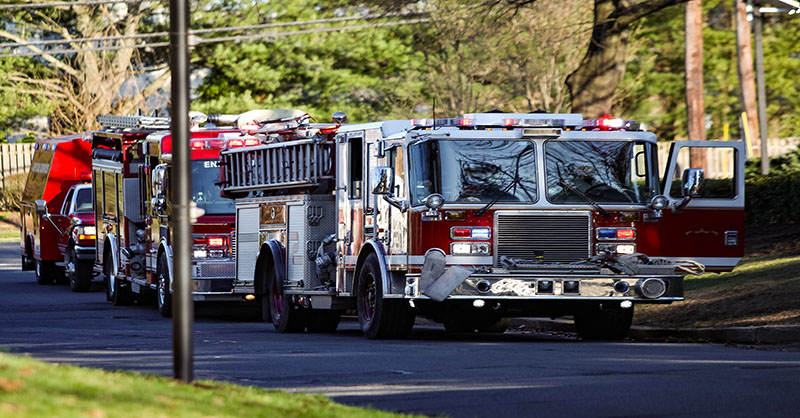Help Prevent Fatalities from First Responder Motor Vehicle Accidents

Response time is important to a first responder because seconds added are directly related to decreased scene safety, increased loss of life, and increased property damage. Additional time adds pressure to an already extremely tense situation. The work is hard, almost always risky, and the danger seems to lurk unknown just beyond that next move.
Who is a first responder?
“First responder” is a broad term that applies to anyone who responds to an emergency. It commonly refers to three primary types of responders:
- Fire Services
- Law Enforcement Services
- Emergency Medical Services (EMS)
Depending on what is happening at an emergency scene, we can expect to see any combination of these three departments responding and trying to arrive quickly.
Scene Safety
According to the National Highway Institute, three injury crashes occur every minute in the United States, putting nearly 39,000 first responders in harm’s way every day.
The first responder needs to arrive at the scene to help those in need, but they should do so in a way that doesn’t hurt others or themself. Other drivers should responsibly yield in a manner that allows the first responder to move on without causing harm to others or themself. Regardless of your role in this situation, lives are typically depending on it.
Once on scene, congestion from emergency operations can significantly increase the potential for secondary crashes to occur. There is also an increased risk from traffic to first responders both during the scene and when they are leaving the scene.
Statistics on Emergency Vehicle Accidents in the United States
According to the National Institute of Occupational Safety & Health (NIOSH), motor vehicle accidents are the leading cause of work-related deaths in the United States. NIOSH goes on to reference three important statistics about first responders:
- 49% of all EMS provider fatalities were related to motor vehicle crashes during the 2013-2018 period. (Bureau of Labor Statistics [2019])
- 98 firefighters died as a result of motor vehicle crashes between 2010 and 2020. (U.S. Fire Administration [2022])
- 498 law enforcement officers died due to vehicle crashes, 28% of all line-of-duty deaths from 2011-2020. (National Law Enforcement Memorial Fund [2021])
These stats clearly show that law enforcement officers and EMS providers are at an increased risk of motor vehicle-related death, but the stats are proportional to the overall number of responses made and the characteristics of the responding vehicles.
Reducing Vehicle-Related Tragedies
Although many variables can contribute to the cause of any one motor vehicle accident, two general areas should be considered:
- Standard Operating Procedures (SOPs)
- Training
Regardless of the vehicle characteristics, all first responder vehicles are made to attract attention. Encountering an emergency response vehicle with lights and sirens on can be an intense experience. Non-emergency drivers can become distracted by emergency response vehicles and even panic. First responders need to drive with this in mind and make considerations based on the circumstances of each situation along the response route.
Clear and Effective Standard Operating Procedures
SOPs should be clear and updated regularly. SOP topics include, but are not limited to, the following:
- Authorization to operate emergency response vehicles
- Use of warning lights and sirens
- Pursuit tactics and termination of pursuit
- Emergency vehicle accidents
- Vehicle maintenance
- Operation of vehicle/apparatus, including the following:
- Backing
- Route restrictions (i.e., clearance, etc.)
- Snow and extreme weather events
- Speed restrictions, yielding and when to take opposing lanes of traffic
- Use of seatbelts and standing up in vehicles
- Distracted driving and use of electronics during response
- Parking on scene and creating traffic barriers
Accountability to the SOPs should be established within your chain of command to ensure that they are consistently followed daily.
First Responder Training
First responders should undergo a significant amount of training, and safe driving techniques are a critical part of this training. First responders who drive/operate emergency response vehicles must be adequately trained to the degree that they achieve something known as unconscious competence. Unconscious competence is the ability to perform a skill/task without seeming to think about it. This level of competency is developed through frequent and repetitive performance of a task over time. This is not something that can be learned through a single course.
Drivers must spend adequate time learning the following:
- Specific functions and characteristics of the vehicles and the equipment kept on the vehicles
- The way vehicles would handle and respond to various situations when being operated
- When a vehicle would exceed its driving limitations, and how to operate within those limitations
Learning should be a blend of classroom and practical skills training but should never consist of only classroom training. Classroom training should cover the SOPs, but drivers need adequate time to operate and learn the vehicle in a safe and secure environment that simulates what the driver will encounter when operating the vehicle during emergency response. These conditions include, but are not limited to, the following:
- Busy intersections
- Lefthand turns
- Driving at night
- Neighborhood streets
- Pursuit distances
Drivers also need to learn their response areas. They need to know where they are going and how they are going to get to the scene without depending on GPS. This is a critical part of training that could significantly reduce the level of distraction while driving.
There is no substitute for adequate preparation of first responders, and this starts with safely arriving on the scene. A team of trained and qualified first responders, who know exactly what to do and how to do it, is key to saving lives. Emergency response organizations should take the time to ensure first responders are equipped with the adequate skills needed to safely do their jobs and protect/preserve lives both on the road and at the scene.









